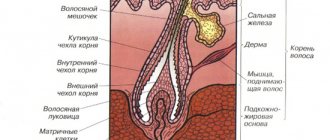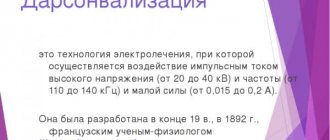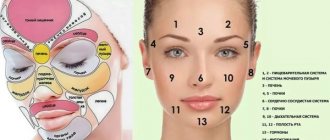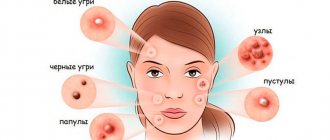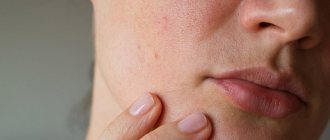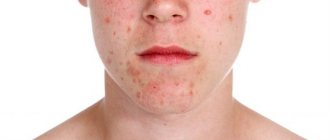Subcutaneous acne: causes and symptoms
The causes of subcutaneous rashes may be as follows29,50,41:
- Endocrine disorders. The work of the sebaceous glands is influenced by androgens. When testosterone levels rise, they produce more sebum, which can lead to breakouts.
- Heredity. It has been proven that if parents have suffered from acne, there is a high probability that the child will also show symptoms of the disease. In addition, there is genetically determined hyperandrogenism, which causes an increased level of sebum production and affects the processes of keratinization.
- Skin injury. Any mechanical impact on the skin can lead to the formation of rashes. We are talking not only about squeezing out acne, but also about frequent and prolonged rubbing of clothing straps, the habit of resting your chin with your hand, etc.
- Nutritional factors. The role of nutrition in the formation of rashes is still controversial. But there is still an opinion that for acne it is better to exclude milk, fatty meats, desserts, spicy and hot dishes. It is better to stick to a low glycemic index diet.
- Use of cosmetics with comedogenic components. The comedogenicity of individual ingredients in a cosmetic product is highly individual. So, in one person it can provoke acne, but in another it may not cause any negative reaction.
- Taking medications. Glucocorticoids, anabolic steroids, anti-epileptic drugs, even some vitamins can cause rashes.
Another factor influencing the formation of acne is hygiene. By itself, it does not cause acne, but it can help create favorable conditions for bacteria to multiply, increase sebum production, and clog pores. Moreover, this applies to both insufficiently frequent cleansing of the skin and frequent washing.
You need to understand that subcutaneous acne needs treatment. It must be pathogenetic, that is, affecting the links of pathogenesis. Clindovit® gel is active against propionibacteria, which cause acne, and also reduces the level of free fatty acids on the skin surface.6
To effectively combat acne, it is necessary to find out the causes that caused the disease and begin treatment on time.
Post-acne
Unfortunately, juvenile acne can leave behind unpleasant consequences called post-acne. At the sites of long-term inflammatory processes in acne, enlarged pores, vascular spots, pigmentation and scars may remain.
The formation of post-acne is promoted by: prolonged course of teenage acne, deep inflammatory elements, squeezing out pimples, late or inadequate treatment.
Do not touch! The main rule of skin care during adolescence is to never squeeze out pimples, blackheads, or other skin growths on your own. This will only worsen her condition.
Scarring after acne remains for life and is a serious cosmetic defect that is difficult to correct only with cosmetic procedures. The only way to prevent these secondary post-acne changes is individual and timely treatment of teenage acne.
How to treat subcutaneous acne?
Before removing a subcutaneous pimple using a Uno spoon or other instrument, you should think carefully about whether you can do this without aggravating the situation. Inept squeezing out of rashes often leads to the spread of the inflammatory process, skin damage, scar formation, and hyperpigmentation spots. This way you will get rid of acne, but your skin will not become more beautiful, just one aesthetic defect will be replaced by another.
It is important to learn to treat acne as a disease that needs to be treated, and not just get rid of the symptoms.
Clindovit® gel is a medicine for subcutaneous acne. It is a topical antibiotic that can be used to treat mild to moderate acne.6
It is better to learn from a specialist about how to get rid of subcutaneous acne. He will find out what caused the acne, prescribe medications, home care, and may also recommend cosmetic procedures that will help improve the condition of the skin.
An integrated approach to combating subcutaneous rashes is the most correct. But it should be remembered that even those procedures that are intended to treat acne may be contraindicated for acne if we are talking about inflammatory elements (papules, pustules, cysts).
Not just age
There are additional factors that can aggravate the situation. The number of acne usually increases several times if:
- there are diseases of the gastrointestinal tract;
- there is a lack of amino and fatty acids;
- malnutrition;
- stress occurs (domestic problems, conflicts);
- weakened immunity;
- incorrectly selected cosmetics;
- the child squeezes out pimples on his own: infection gets into open wounds, an inflammatory process occurs, which provokes the appearance of more and more pimples;
- the child takes medications for a long time.
Even though teenage acne is not life-threatening, it can cause a lot of trouble for teenagers. Such an ordinary disease can negatively affect the future lives of young people: psychological discomfort from “less than ideal appearance” can cause low self-esteem, social alienation and isolation.
Complications
Ignoring the treatment of stage 2-3 acne is a pathology. Consequences:
- rapid expansion of pores;
- formation of post-inflammatory pigmentation;
- pronounced erythema spots;
- manifestation of milia;
- scarring, atheroma.
In cosmetology education – post-acne.
The sebaceous glands activate the function of subcutaneous sebum. Rapid accumulation of sebum in the sebaceous glands. The appearance of stretch marks, the formation of hypertrophy.
Pigment spots are malfunctions in the pigment formation process. Consequences of active insolation during the development of a chronic disease, active squeezing, increased level of trauma.
Erythema formations of spots. The appearance of pimples in problem areas. An alternative name is a stagnant spot. Formation due to disruptions in blood circulation during severe inflammatory processes.
Milia are neoplasms of round capsules with a high content of natural sebum. Localization is superficial. Under the epidermal film, often on the eyelids, around the eyes, in the temporal region, lower part of the face. Mechanical removal.
Scar formations appear in complex forms of development of common pathology. Damage to the perifollicular dermis is observed.
Antimicrobials for treating acne at home
For inflammatory elements of acne in the form of papules and pustules, antibacterial drugs for external use can be used independently, since they do not have the pronounced effectiveness of systemic antibiotic therapy.
Topical preparations suppress the growth of bacteria:
- Benzoyl peroxide (Baziron AS) gel.
- Azelloic acid (Skinoren) gel and cream.
- Fusidic acid ointment, cream.
- Erythromycin ointment.
- Clindamycin (Dalacin-gel).
- Lincomycin ointment.
- Metronidazole gel.
- Pyolysin ointment.
- Zenerite (erythromycin/zinc acetate) powder.
- Zinc hyaluronate (Curiosin) gel.
Degrease and disinfect the skin with alcohol solutions with antibiotics (5% chloramphenicol), 2% resorcinol, 2 - 5% salicylic acid solution, 5 - 10% alcohol solution of camphor.
Don't squeeze pimples! When squeezed, the infection spreads into the deep layers of the skin and non-inflamed elements.
Proper care
Skin care for acne is a daily ritual, all stages of which must be learned, not confused or skipped. You need to wash your face twice a day with warm water. Avoid soap and use special products for oily skin for cleansing (better ─ gels and foams). After washing, use lotion or tonic - they prepare the skin for applying cream, disinfect and dry, tighten pores, and have a mattifying effect. The final stage is a special cream for oily and problem skin.
In the active stage of acne, the use of decorative cosmetics is not advisable, but during “quiet” periods the skin is quite tolerant of makeup. The main thing is that it is light and has few layers. When choosing products, you need to pay attention to the packaging: the “non-comedogenic” label is required. Concealing treatments with pigmented particles that even out skin tone will add calmness and confidence.
Acne treatment time frame
Treatment of chronic deviation depends on the severity of the course. Duration is determined by the characteristics of the patient. Advanced cases require complex treatment for months or years. It is necessary to take medications made with isotretinoin, followed by the use of external components. After the end of the therapeutic method, a rehabilitation period begins, social adaptation, and organization of proper care. Preventing the development of new pathology and activation of inflammatory processes.
Is sunbathing good for acne?
Illiterate dermatologists recommend prolonged exposure to direct sunlight. The manifestation of a pronounced side effect, the rapid spread of ulcers and acne throughout the patient’s body.
An increased dosage of ultraviolet radiation rapidly reduces the level of functioning of the immune system. There is a deterioration in health. Regular visits to the solarium - progressive age-related changes, risks of cancer.
Regular use of isotretinoin-based medications increases sensitivity to ultraviolet radiation. Local and general antibiotics tend to have a phototoxic effect.
Complex therapy
A mild form of the disease is complex external therapy. Treatment is as prescribed by the treating doctor based on the diagnostic results. Methods:
- mechanical;
- chemical peeling.
Peeling is based on salicylic and pyruvic acid extract. Mechanical cleaning is the middle stage of treating the disease. An initial cleaning step is often necessary. It is planned to complete the chemical peeling with mechanical peeling. Additionally, complex use of general and local medications, antibiotics.
Treatment of moderate disease is an addition to the external type of systemic therapy. Peculiarities:
- comprehensive laboratory tests: clinical blood test, biochemical diagnostics, general urine analysis;
- in-depth study of the patient’s hormonal background.
Prescription of local and general antibiotics, use of oral contraceptives with a pronounced antiandrogenic effect.
Reference: androgens for effective treatment of women. Purpose - based on the results of a complete examination of the patient’s hormonal imbalances. Many oral hormonal medications have a pronounced effect: “Zhanin”, “Yarina”.
The complex course of the disease is characterized by taking medications based on isotretinoin. Medicines for advanced stages of chronic disease. Contraindicated in women prone to pregnancy - after prescribing contraceptive medications or procedures. Severe side effects:
- severe severe headaches;
- increased feeling of dryness;
- increased anxiety;
- periodic outbreaks of dizziness.
The use of isotretinoin-based medications is accompanied by careful monitoring by a dermatologist. Treatment of post-acne is complex and time-consuming compared to common acne. If there are primary signs of an inflammatory process, immediately contact an experienced dermatologist at the medical center.
The psychosomatic state of the patient in the presence of a chronic disease is a separate side effect. Pronounced feeling of stiffness, constriction. The resulting facial defects force people to lead a hidden lifestyle. Side effects:
- the rapid increase in numerous complexes;
- expressed feelings of resentment;
- significant deterioration in mood.
The doctor establishes close, trusting cooperation with patients. Parallel work is carried out with a professional psychologist. The drug and the correction method for treating the chronic course of the pathology are specified. Getting the first visible results.
Pimples* on the cheeks: which organ can hurt?
There is an opinion that there is a connection between the location of the rashes on the face and the functioning of the organs, that is, by the pimples* on the cheeks it is determined which organ is suffering. And this is what the rashes in this zone mean [208]:
- disturbances in the functioning of the stomach (pimples* are located under the cheek line);
- lung diseases (inflammation is localized in the middle and lower parts);
- diseases of the gums and teeth (rashes in the lower part).
In addition, rashes on the cheeks may indicate a lack of positive emotions and lack of oxygen. But there is no scientific evidence that acne* on the cheeks and the functioning of organs are connected.
Classification
Chronic disease has a classification. It differs by the age of the patient.
| Age | Description |
| Youth | Formation of comedones, papules, pustules, cystic pimples, rapid development of acne |
| Adults | Acne: late, inverse, sports, spherical |
| Childhood | Acne in newborns, acquired in children |
The comedo form is a precursor to the papulopustular stage of acne development. Stable development from the age of 8. The indicator of greasiness and hair increases. Formation of microcomedones in the sebaceous glands, developing into a closed type.
The formation of the papulopustular form is characterized by a profuse rash over all parts of the body. Severe manifestations form scarring in damaged areas of the inflammatory process.
The nodular course complicates the disease with the rapid appearance of acne. Localization in the back area.
